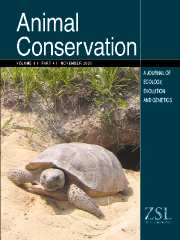Crossref Citations
This article has been cited by the following publications. This list is generated based on data provided by
Crossref.
Webb, Jonathan K
and
Shine, Richard
2000.
Paving the way for habitat restoration: can artificial rocks restore degraded habitats of endangered reptiles?.
Biological Conservation,
Vol. 92,
Issue. 1,
p.
93.
Downes, Sharon J.
and
Adams, Mark
2001.
GEOGRAPHIC VARIATION IN ANTISNAKE TACTICS: THE EVOLUTION OF SCENT-MEDIATED BEHAVIOR IN A LIZARD.
Evolution,
Vol. 55,
Issue. 3,
p.
605.
Bonnet, Xavier
Pearson, David
Ladyman, Mitchell
Lourdais, Olivier
and
Bradshaw, Don
2002.
‘Heaven’ for serpents? A mark–recapture study of tiger snakes (Notechis scutatus) on Carnac Island, Western Australia.
Austral Ecology,
Vol. 27,
Issue. 4,
p.
442.
Bonnet, Xavier
Pearson, David
Ladyman, Mitchell
Lourdais, Olivier
and
Bradshaw, Don
2002.
‘Heaven’ for serpents? A mark–recapture study of tiger snakes (Notechis scutatus) on Carnac Island, Western Australia.
Austral Ecology,
Vol. 27,
Issue. 4,
p.
442.
Reed, Robert N.
and
Shine, Richard
2002.
Lying in Wait for Extinction: Ecological Correlates of Conservation Status among Australian Elapid Snakes.
Conservation Biology,
Vol. 16,
Issue. 2,
p.
451.
Rodríguez-Robles, Javier A.
2002.
Feeding ecology of North American gopher snakes (Pituophis catenifer, Colubridae).
Biological Journal of the Linnean Society,
Vol. 77,
Issue. 2,
p.
165.
Webb, Jonathan K.
Christian, Keith A.
and
Fisher, Peter
2002.
Fast Growth and Early Maturation in a Viviparous Sit-and-Wait Predator, the Northern Death Adder (Acanthophis praelongus), from Tropical Australia.
Journal of Herpetology,
Vol. 36,
Issue. 3,
p.
505.
Shine, Richard
and
Li-Xin, Sun
2002.
Arboreal ambush site selection by pit-vipers Gloydius shedaoensis.
Animal Behaviour,
Vol. 63,
Issue. 3,
p.
565.
Webb, Jonathan K.
Brook, Barry W.
and
Shine, Richard
2002.
What makes a species vulnerable to extinction? Comparative life‐history traits of two sympatric snakes.
Ecological Research,
Vol. 17,
Issue. 1,
p.
59.
Pringle, Robert M.
Webb, Jonathan K.
and
Shine, Richard
2003.
CANOPY STRUCTURE, MICROCLIMATE, AND HABITAT SELECTION BY A NOCTURNAL SNAKE, HOPLOCEPHALUS BUNGAROIDES.
Ecology,
Vol. 84,
Issue. 10,
p.
2668.
Webb, Jonathan K.
Brook, Barry W.
and
Shine, Richard
2003.
Does foraging mode influence life history traits? A comparative study of growth, maturation and survival of two species of sympatric snakes from south‐eastern Australia.
Austral Ecology,
Vol. 28,
Issue. 6,
p.
601.
Fitzgerald, Mark
Shine, Richard
and
Lemckert, Francis
2003.
A reluctant heliotherm: thermal ecology of the arboreal snake Hoplocephalus stephensii (Elapidae) in dense forest.
Journal of Thermal Biology,
Vol. 28,
Issue. 6-7,
p.
515.
Webb, Jonathan K.
Brook, Barry W.
and
Shine, Richard
2003.
Does foraging mode influence life history traits? A comparative study of growth, maturation and survival of two species of sympatric snakes from south‐eastern Australia.
Austral Ecology,
Vol. 28,
Issue. 6,
p.
601.
Shine, R.
Bonnet, X.
Elphick, M. J.
and
Barrott, E. G.
2004.
A novel foraging mode in snakes: browsing by the sea snake Emydocephalus annulatus (Serpentes, Hydrophiidae).
Functional Ecology,
Vol. 18,
Issue. 1,
p.
16.
Fitzgerald, Mark
Shine, Richard
and
Lemckert, Francis
2004.
Life history attributes of the threatened Australian snake (Stephen's banded snake Hoplocephalus stephensii, Elapidae).
Biological Conservation,
Vol. 119,
Issue. 1,
p.
121.
Webb, Jonathan K.
and
Whiting, Martin J.
2005.
Why don't small snakes bask? Juvenile broad‐headed snakes trade thermal benefits for safety.
Oikos,
Vol. 110,
Issue. 3,
p.
515.
PEARSON, D.
SHINE, R.
and
WILLIAMS, A.
2005.
Spatial ecology of a threatened python (Morelia spilota imbricata) and the effects of anthropogenic habitat change.
Austral Ecology,
Vol. 30,
Issue. 3,
p.
261.
Newell, David
and
Goldingay, Ross
2005.
Distribution and habitat assessment of the Broad-headed SnakeHoplocephalus bungaroides.
Australian Zoologist,
Vol. 33,
Issue. 2,
p.
168.
WEBB, JONATHAN K.
SHINE, RICHARD
and
CHRISTIAN, KEITH A.
2005.
Does intraspecific niche partitioning in a native predator influence its response to an invasion by a toxic prey species?.
Austral Ecology,
Vol. 30,
Issue. 2,
p.
201.
Llewelyn, John
Shine, Richard
and
Webb, Jonathan K.
2006.
Time of testing affects locomotor performance in nocturnal versus diurnal snakes.
Journal of Thermal Biology,
Vol. 31,
Issue. 3,
p.
268.


